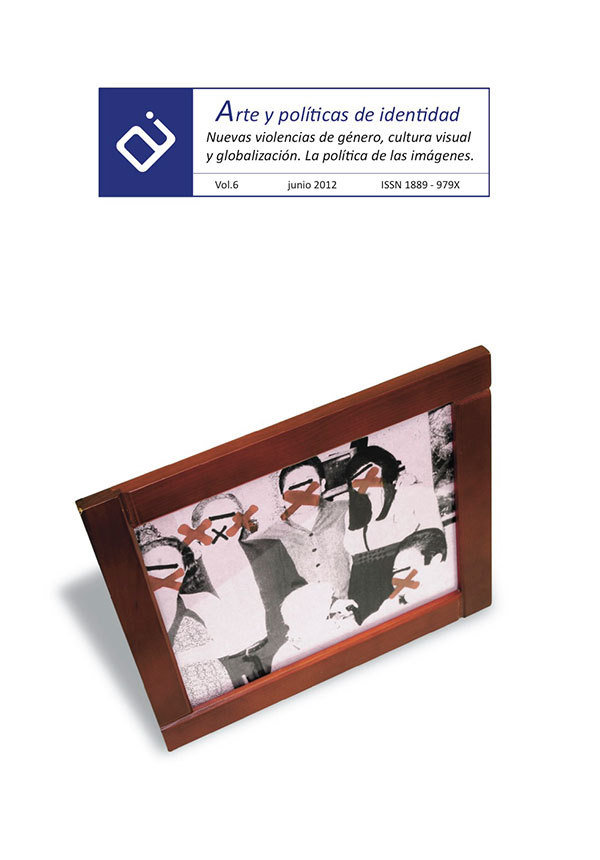Pilitical Bodies in the Conflict Zone: Hannah Wilke or the theatralization of Femininity in an Agonistic Space
Abstract
This paper raises the need to review hegemonic interpretations of questions that arise in times of political fracture within dissident groups. The artist Hannah Wilke is brought to exemplify this question and, more specifically, her reasons to produce the poster Marxism and art. Beware of Fascist Feminism are analysed. Wilke’s work is considered here as a clear illustration of how theoretical tools are not always ready to interpret the actions of the artists in their historical context. Removed from an essentialist extra-discursive perspective, proposals such as Wilke’s acquire a different sense and show the impossibility of defending a closed identity in active democratic spaces.
Downloads
-
Abstract703
-
PDF (Español (España))417
References
Barry, J. & Flitterman-Lewis, S. (1991). Textual Strategies: The Politics of Art-Making. En H. Robinson (Ed.). Visibly Female.Feminist Art Criticism. An Anthology. Nueva York: Universe Books. (Publicación original en 1988).
Benthall, J. (1977). Importancia de la ecología. En G. Battcock, La idea como arte. Documentos sobre el arte conceptual. Barcelona: Gustavo Gili.
Butler, J. (2007): El género en disputa. El feminismo y la subversión de la identidad (1990). Barcelona: Paidós. (Publicación original en 1990)
Cottingham, L. (2002). Seeing through the Seventies. Essays on Feminism and Art. Nueva York: G+B Arts International.
De Lauretis, T. (1990). La esencia del triángulo, o tomarse en serio el riesgo del esencialismo: teoría feminista en Italia, los E.U.A. y Gran Bretaña. Debate Feminista, año 1, vol. 2. (Publicación original en 1989).
D’Souza, A. (2010). Float the Boat. Finding a Place for Feminism in the Museum. En C. Butler & A. Schwartz (Ed.). ModernWomen. Women Artist at the Museum of Modern Art. Nueva York: MoMA Publications.
Fernández Orgaz, L. (Ed.). (2006). Hannah Wilke. Exchanged Values. Catálogo de exposición.Vitoria-Gasteiz: Artium.
Frueh, J. (1996). Erotic Faculties. Berkeley/Los Angeles/Londres: University of California Press.
-------------(1991). Feminism. En H. Robinson (Ed.). Visibly Female.Feminist Art Criticism. An Anthology. Nueva York: Universe Books. (Publicación original en 1989).
Goldman, S. (2006). Herejías e historia: Hannah Wilke y el movimiento artístico feminista norteamericano. En L. Fernández Orgaz (Ed.). Hannah Wilke. Exchanged Values. Cat. exp. Vitoria-Gasteiz: Artium.
Isaak, J. A. (1996). Feminism & Contemporary Art. The Revolutionary Power of Women’s Laughter. Londres y Nueva York: Routledge.
Kelly, M. (2008). Imágenes que desean/Imaginar el deseo. En M. A, Hernández-Navarro & I. Tejeda (Eds.). Mary Kelly. La Balada de Kastriot Rexhepi. Catálogo de exposición. Murcia: EspacioAV/Región de Murcia. (Publicación original en 1984).
Laclau, E. & Mouffe, C. (2004). Hegemonía y estrategia socialista. Buenos Aires/México: Fondo de Cultura Económica. (Publicación original en 1985).
Lippard, L. R. (1976). From the Center: Feminist Essays on Women’s Art. Nueva York: E.P. Dutton.
Rickey, C. (1994). Writing (and Righting) Wrongs: Feminist Art Publication. En N. Broude & M. Garrad (Eds.). The Power of Feminist Art. The American Movement of the 1970s History and Impact. Nueva York: Harry N. Abrams.
Spivak, G. C. (1988). Subaltern Studies: Deconstructing Historiography. En R. Guha, & G. C. Spivak (Eds.). Selected Subaltern Studies. Nueva York: Oxford University Press. (Publicación original en 1985).
Wilke, H. (1978). Artist Hannah Wilke Talks with Ernst. Oasis de Neon 1, n1. La referencia aparece en Kubitza, A. (1996). Rereading the Readings of The Dinner Party in Europe. En A. Jones (Ed.). Sexual politics, Judy Chicago’s Dinner Party in Feminist Art History. Catálogo de exposición. Berkeley/Los Angeles/Londres: University of California.
Works published in this journal are subject to the following terms:
- The Service of Publications from the University of Murcia (publishing house) keeps the published works’ copyrights, and favors and allows the reuse of these works under the license indicated in point 2.
- Works are published in the journal’s online edition under the license Creative Commons Reconocimiento-NoComercial-SinObraDerivada 3.0 España(texto legal). They can be copied, used, disseminated, transmitted and publicly exhibited, as long as: i) the author and original source of publication are cited (journal, publishing house and work’s URL); ii) they are not used for commercial purposes; iii) the existence and specifications of this license are mentioned.
3. Conditions for auto-file. It is allowed and encouraged that authors share electronically their pre-print version (the pre-reviewed version) and /or post-print version (the reviewed and accepted version) of their Works before the publication, since it promotes its circulation and dissemination. RoMEO color: green.










